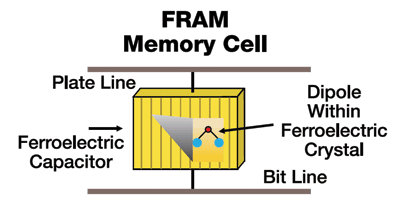As noted in the adjoining column Wolverine, a small predator with a reputation for ferocity and strength out of proportion to its size, is the name selected by Texas Instruments for its ultra-low-power series of 16-bit MSP430 microcontroller devices said to cut the industry’s best previous active power consumption by half, achieving sub-100μA/MHz performance.
The secret sauce behind this low power accomplishment is embedded FRAM, an acronym for ferroelectric random access memory (and a registered trademark of Ramtron International Corp.) FRAM is a non-volatile memory, meaning that like flash or EEPROM it can hold data even after it is powered off.
An FRAM memory cell consists of a capacitor connected to a plate and bit line (see illustration at right). The orientation of the dipole within the capacitor determines whether a “1” or “0” is stored. The dipole orientation can be set and reversed by applying voltage across either line. FRAM is non-volatile because of the special dielectric material used in the storage capacitor: a ceramic that allows use of the so-called ferroelectric effect. While a full explanation of ferroelectrics is beyond the scope of this article, suffice it to say that this material’s electric polarization can be reversed by the application of an external electric field.

FRAM’s big advantage is that it writes at the process core voltage (in this case 1.5V) so it is able to operate without a charge pump, unlike non-volatile memory technologies flash and EEPROM that require high voltage for erasing. Compared to flash memory running at equal speed, FRAM consumes 1/250th of the power needed (FRAM consumes 9 μA at 12 Kbytes/s while flash consumes 2,200 μA at 12 Kbytes/s).
Furthermore, the energy consumed by a FRAM MCU becomes substantially lower when FRAM’s lower power consumption is multiplied by its much faster write speed. For example, a typical EEPROM write operation takes 10 ms for the write to be effective. The actual write time to a FRAM memory cell is less than 50ns. The reason for this longer EEPROM write duration is the delay in developing the elevated voltage by the charge pump and “soak times” required to move the electrical charge into or out of the floating gates.
FRAM can write data much faster primarily because, unlike EEPROM where you must have two steps to write data (a write command, followed by a read/verify command), FRAM’s write memory function happens in the same process as read memory. For its MSP430F5438A MCU, TI specifies between 37 and 85 μs to program one word, depending on programming mode and process conditions; for flash-based microcontrollers, programming times in the range of 3 to 5 ms are sometimes specified. This does not include a pre-erasure of the flash segment to be re-programmed. The pre-erasure will add several milliseconds. FRAM also does not need to erase the data before writing.
FRAM memory can function equally as program memory or data memory storage. In other non-volatile memory types data and programs are kept in separate memories: RAM for data and flash or ROM for program storage. In this way by using FRAM developers have the ability to dynamically partition the memory block to meet the needs of the application.
Finally, embedded FRAM also offers write endurance that competing memory technologies cannot match: 1014 (100 trillion) cycles, or about 10 billion times better than flash, which offers about 100,000 write cycles (EEPROM gives you about 500,000). TI reports that JEDEC industry standard test specifications for non-volatile memory guarantees 10 years of operation and data retention at 85°C for FRAM. This increased write endurance is well suited for data logging, remote sensors, equipment powered by energy harvesting and other applications. ■
Advertisement
Learn more about Mouser Electronics





